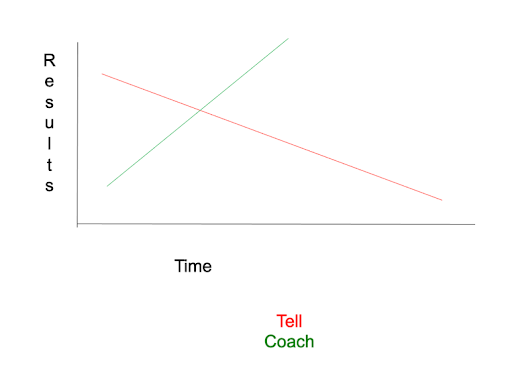In my office, we like to dine out on this little anecdote.
A University lecturer we know contacted her HR department and asked “How do I go about getting myself some coaching?” Their reply was, “Why, what’s wrong with you?”
This mentality is something we must absolutely avoid if we’re to have any chance of coaching doing its job. Coaching is a fantastic tool to use in all manner of work situations – as we shall see – but only if it’s positioned in a positive way.
So the question remains, when should you use coaching?
I suppose the simple answer is, now! Get on with it! Look at all the benefits everyone speaks about, why wait? But I realise you need a more refined answer than that.
Let’s first consider what makes the average manager consider the coaching approach in the first place. After all most work situations are really not new; they’ve been happening for decades, so why do we need a different approach to dealing with them?
The answer lies in the ever-decreasing effectiveness of the ‘tell and instruct’ approach.
‘Tell and instruct’
Consider this diagram:

When somebody is new to the team, we need obviously to do a certain amount of telling. When people are new, they need information and instructions. And it’s arguably a little too soon to be asking for their views on the way forward. Although, arguably, you might really benefit from their objectivity).
When time is short, or in crisis situations we need also to tell people what to do, because the needs of the situation require it. There is no time for a debate and the risks of inaction outweigh the risks of doing the wrong thing.
Quality of output has taken on great importance in recent years.
The tell style is perfectly appropriate in these situations but then the passage of time intervenes and telling becomes at first inappropriate and eventually counter-productive. People have information and instructions but now want to exercise a little responsibility.
Crises eventually pass and things calm down.
Timing is everything
Coaching is an investment of time and like all longer-term investments, the pay-off is not immediate. This can be unacceptable at work, and even I would argue that it can sometimes be premature to coach, or the timing can be wrong.
So the graph illustrates a cross-over point where the effectiveness of telling falls dramatically and coaching comes into its own. Unfortunately, there are no hard and fast rules for where this point lies for each individual whom you coach, the real trick is for you to become aware of their changing needs and circumstances and spot when it’s time to switch lines and move from the more controlling ‘tell what and how’, approach to the more empowering (responsibility generating) coaching approach.
When learning from the experience is paramount, it’s time to coach
There is very little learning that happens from the tell style apart from perhaps learning how to keep our heads down and learning how to cover up errors.
Being told what to do does not engage our brains and so we do not forge new connections and insights; we do not learn. There is also the problem of recall with some suggestion that we remember as little as 10% of what we’ve only ever been told.
Coaching, with its emphasis on awareness, responsibility and trust creates perfect conditions for enduring learning.
When there is a need to avoid repeating errors, to find new ways of doing things and to create independence of thought there is a consequent need for learning and therefore coaching.
When motivation appears to be waning, it’s time to coach
This can be a sure sign that the tell approach has done its job. Unless the coachee feels completely lost – in which case they’ll still need a lot of direction – motivation will be higher when we involve people in what they do through coaching and fostering a sense of performance, learning and enjoyment.
Look out for people beginning to question your instructions and disagreeing with your suggestions. This does not make them right and you wrong, it’s just an indicator that they’re beginning to think independently.
Why not harness this rather than resisting it?
When the quality of output has become crucial, it’s time to coach
There’s an old saying in sports coaching along the lines of ‘you can make me run, but only I can choose to run fast’. There is a natural version of this in coaching at work along the lines of, ‘You can make me work, but only I can choose to work well’.
Quality of output has taken on great importance in recent years.
Driven by innovations in manufacturing such as ‘Just in Time’ and ‘Agile Working’ all sorts of organisations are seeking ways to increase the quality of what they offer in line with their customer’s increasing expectations.
Getting a workforce to embrace quality is difficult at the best of times and downright impossible if we command them to improve quality; it doesn’t work like that.
In the end, the importance of quality resides in the hearts and minds of employees and thus they need convincing and to feel involved, which once again requires us to move from telling to coaching.
When people need to work independently, it’s time to coach
Gone are the days (thankfully) when managers would peer out from their desks to see their people lined up at desks of their own or standing at production lines or similar.
Now more than ever, people who comprise our teams may not even be in the same country, let alone in the same building – even if the organisation still has a building!
When it’s time to let them take things forward in their own way, it’s time to coach.
In this environment, the need to create teams of independent thinkers who self-select the right actions and are perfectly happy to do so is unavoidable. Telling, directing and instructing requires constant reinforcement and even if the technology is there to help managers do this, they certainly don’t have the time.
Of course, there will always be certain critical tasks where failure would lead to disaster that managers need to control in every detail. But these are fewer than we care to admit and for the most part. Coaching will get us further than telling when dealing with a team of people who have long since acquired basic skills and knowledge to understand the basic mechanics of their job.
When it’s time to let them take things forward in their own way, it’s time to coach.





